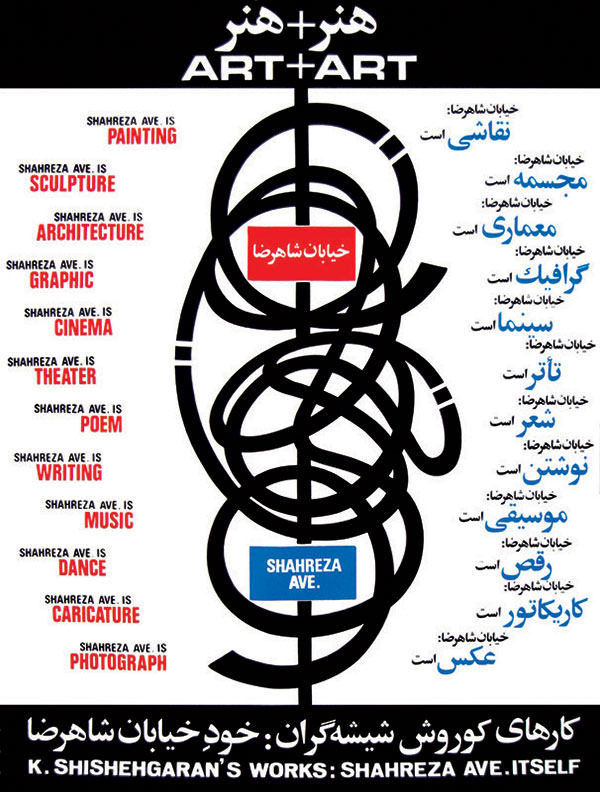Ettela’at newspaper, March 16, 1977, 41. All translations from Persian are mine, except when otherwise stated.
“Deductive structure” is a term first used by Michael Fried in his discussion of postwar American abstract painting. “One of the most crucial formal problems” of the postwar period, according to Fried, was “that of finding a self-aware and strictly logical relation between the painted image and the framing edge.” Cited in Maria Gough, Artist as Producer (Berkeley: University of California Press, 2005), 47.
Shahla Yeganeh, “A Painter with a New Message: Interview with Koorosh Shishegaran,” Roodaki 19 (1973): 25.
Koorosh Shishegaran, artist’s statement for the second installment of “Reproductive Art” at Mes Gallery, 1973.
Interview with Koorosh Shishegaran, Ferdowsi 1141 (December 1973): 18.
For a philosophical account of the ontology of technological print and its significance in art since conceptualism, see Peter Osborne, “Infinite Exchange: The Social Ontology of the Photographic Image,” Philosophy of Photography 1, no. 1 (March 2010): 59–68.
Jalil Ziapour, “Painting,” Khoroos Jangi (The Fighting Cock) 2 (1949): 12.
Terry Smith, “The Provincialism Problem,” Artforum 12, no. 1 (September 1974): 54–59; reprinted in Journal of Art Historiography 4 (June 2011).
Ziapour, “Painting,” 13.
Smith, “The Provincialism Problem.”
Karim Emami, “Saqqakhaneh School Revisited,” Saqqakhaneh (exhibition catalogue), Tehran Museum of Contemporary Art, 1977, reprinted in Iran Modern (exhibition catalogue), Asia Society Museum, 2014, 230. (Written originally in English by Emami.)
Shiva Balaghi, “Iranian Visual Arts in ‘The Century of Machinery, Speed, and the Atom’: Rethinking Modernity,” in Picturing Iran: Art, Society and Revolution, eds. Shiva Balaghi and Lynn Gumpert (London: I. B. Tauris, 2002), 24.
On the political construction of authenticity and Iranian-ness in the context of the 1960s and ’70s, see Ali Mirsepassi, Transnationalism in Iranian Political Thought: The Life and Times of Ahmad Fardid (Cambridge: Cambridge University Press, forthcoming in 2017).
Hamid Keshmirshekan, “Neo-Traditionalism and Modern Iranian Painting: The Saqqa-khaneh School in the 1960s,” Iranian Studies 38, no. 4 (December 2005): 613.
For a scathing contemporary critique of Pope’s ahistorical approach to art history, see Meyer Schapiro’s review of A Survey of Persian Art: From Prehistoric Times to the Present in Art Bulletin 23, no. 1 (March 1941): 82–86.
In his recent book Tahavvolat-e Tasviri-e Honar-e Iran: Barrasi-e Enteghadi (Visual Transformations of Iranian Art: A Critical Survey) (Tehran: Nazar Publishers, 2016), Siamak Delzendeh makes a point by trying to read major transformations of modern Iranian art as a derivative of Pope’s theory of the “decorative” in the art of Iran. Despite his frequent references to interesting archival documents, Delzendeh nonetheless homogenizes a diverse history and leaves some ideological constructions unchecked.
For Corbin, Iran manifested an authentic mode of spirituality that he termed “Iranian Islam”—a transhistorical trajectory “reaching from the ancient Persian prophet Zoroaster through the gnostic prophet Mani and spanning the medieval philosophers Suhrawardi and Mulla Sadra” (Steven M. Wasserstrom, Religion after Religion: Gershom Scholem, Mircea Eliade, and Henry Corbin at Eranos, Princeton, NJ: Princeton University Press, 1999, 134). In the early 1970s, one of Corbin’s chief disciples, Daryoush Shayegan, was a regular lecturer at Hunarkadeh, advising students on “spiritual” manifestations of “Iranian Islam” in the country’s arts.
Negar Azimi, “Interview with Kamran Diba,” Iran Modern (exhibition catalogue), Asia Society, 2013, 80.
There is no time and space here to go into detailed formal analysis of Saqqakhaneh artworks to demonstrate how identity politics is reflected formally at the level of picture plane in these works. That is a task I set out for myself in another article that is yet to published called “How Anti-Colonial Art Served Authoritarian Nationalism: Modernism, Vernacular Culture and the Iranian State.”
Jalal Al-e Ahmad, “Tokhm-e Se Zarde-ie Panjom” (The Fifth Triple-Yolk Egg), in Karname-ie Se Saleh (Three-Year Recapitulation) (1968), reprinted in Al-e Ahmad, Adab va Honar-e Emrooz-e Iran (Iran Contemporary Art and Literature), vol. 3, ed. Mostafa Zamaninia (Tehran: Mitra, 1994), 1386.
Ruin Pakbaz, Talar-e Iran (Iran Gallery) (Tehran: Ministry of Arts and Culture, 1976), 5.
Peter Burger, Theory of the Avant-Garde (Manchester: Manchester University Press, 1984), 49.
Ayandegan newspaper, April 10, 1977, 6.
Rastakhiz newspaper, republished in Pages 6 (October 2007): 111.
Ayandegan newspaper, March 26, 1977, 6.
Ayandegan newspaper, April 10, 1977, 6.
An earlier version of this essay was presented at the conference Artists’ Critical Interventions into Architecture and Urbanism (University of Warwick, July 15–16, 2016). I would like to thank the organizers and participants, particularly David Hodge, whose comments were instrumental in the formation of this essay. I am also grateful to Nasrin Tabatabai and Babak Afrassiabi, who first unearthed ART+ART in 2007 in the sixth volume of their publication Pages. Images of works by Koorosh Shishegaran and newspaper clippings are reproduced here courtesy of the artist.
